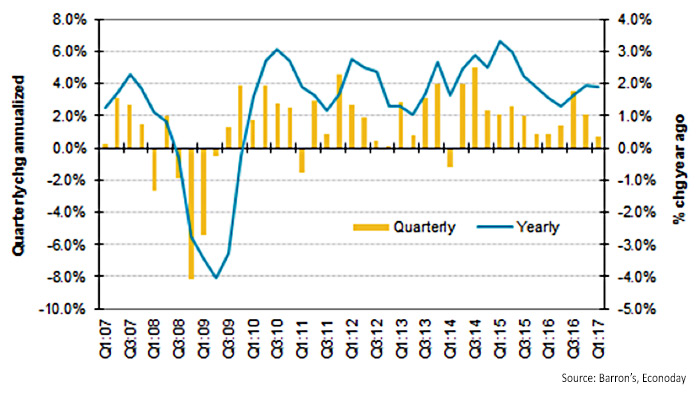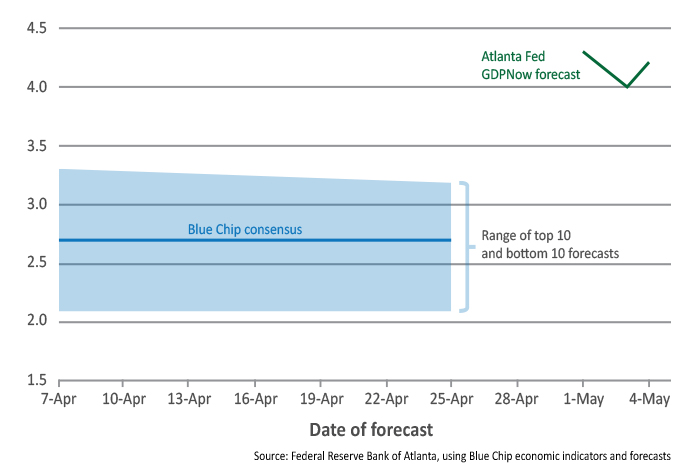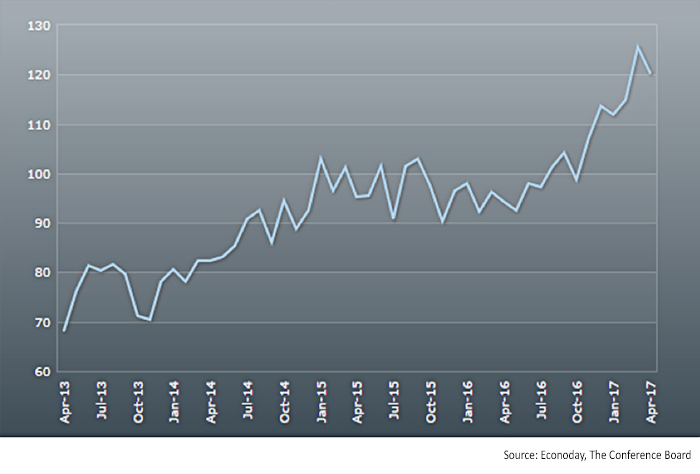
U.S. first-quarter gross domestic product growth (GDP) data, released on April 28, 2017, showed that the U.S. economy grew at its slowest pace in three years. Barron’s noted, “The weakest showing since the last recession for consumer spending held down first-quarter GDP, which could manage only a 0.7 percent rate of annualized growth. Consumer spending rose at only 0.3 percent, which is by far the worst showing since no change in fourth-quarter 2009.”
REAL U.S. GDP GROWTH

Estimates for Q2 U.S. GDP vary widely, though most economists expect growth to pick up significantly. The consensus estimate stands at about 2.7%, but CNBC reports that Macroeconomic Advisors has an estimate for 3.7%. The widely-watched GDPNow forecast of the Atlanta Fed is well above the consensus range, with a recent call for 4.2% year-over-year growth for Q2.
ATLANTA FED GDPNOW FORECAST: Q2 2017
Quarterly percent change (SAAR)

Federal Reserve Board Chair Janet Yellen and her colleagues apparently agree somewhat with the Atlanta Fed’s rosier outlook, with last week’s FOMC official statement saying,
“The Committee views the slowing in growth during the first quarter as likely to be transitory and continues to expect that, with gradual adjustments in the stance of monetary policy, economic activity will expand at a moderate pace, labor market conditions will strengthen somewhat further, and inflation will stabilize around 2 percent over the medium term. Near-term risks to the economic outlook appear roughly balanced.”
There is little doubt, however, that U.S. real economic activity has hit a bit of a rough patch. For example, after several months of beating expectations, the ISM manufacturing report released last week missed forecasts by a wide margin: 54.8 actual versus 56.5 consensus expectations.
Bespoke Investment Group’s review of recent economic reporting shows a marked downturn over the past month, with the majority of economic data points falling below expectations. However, they do also note that “it is important to remember that while data has not quite lived up to expectations, it hasn’t been weak on an absolute basis. The economy remains on a firm footing.”
A positive outlook continues to be seen in softer measures of consumer and business confidence, as well as in investor sentiment and the performance of U.S. equity indexes. While consumer confidence eased a bit in April, it is still at levels close to post-recession highs.
CONSUMER CONFIDENCE: APRIL 2017

The real question is how will the recent divergence between hard and soft economic data be resolved? Markets, and confidence measures, are obviously placing a great deal of emphasis on an effective rollout of the Trump administration’s pro-growth agenda, including tax reform, the budget plan, regulatory reform, and infrastructure spending. Even the Trump administration itself realizes that it will be a lengthy and arduous process.
U.S. News and World Report reported recently, “Treasury Secretary Steven Mnuchin acknowledged it could take some time before President Donald Trump’s plan for 3 percent annual economic growth becomes a reality. Speaking at an event hosted by the Milken Institute in Los Angeles on Monday morning, Mnuchin outlined several of his and his boss’ priorities while indicating it will ‘probably’ take two years for the economy to hit 3 percent expansion.”
